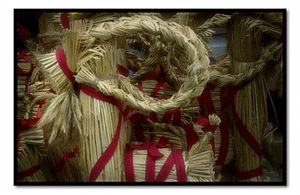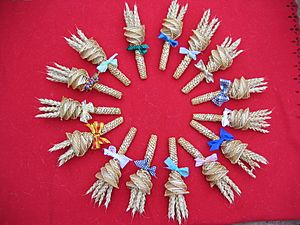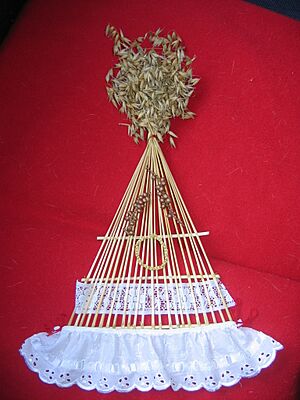Corn dolly facts for kids
Corn dollies or corn mothers are special decorations made from straw. People in Europe used to make them during harvest time, long before big machines did all the farm work.
In old European cultures, before Christianity, people believed that the spirit of the grain lived in the crops. When the crops were harvested, they thought this spirit became homeless. So, they made hollow shapes from the last bundle of wheat or other grains. These "corn dollies" would give the spirit a home for the winter. In the spring, the dolly would be ploughed into the first furrow of the new season. This was meant to help the new crops grow well.
Contents
What are Corn Dollies?
Long ago, people believed that a "Corn-mother" or "Corn-maiden" lived in the fields. When the last of the grain was cut, they would make a doll from it. This doll was often called the Corn-mother or the Old Woman. It was brought home with the last wagon of crops.
Sometimes, the last bundle of grain was even dressed in women's clothes! In some places, the Corn-mother was soaked with water. This was probably a way to ask for rain for the next year's crops. The finest parts of the grain were sometimes made into a wreath. The prettiest girl in the village would wear this wreath. The Corn-mother doll was often placed in the barn to keep mice away.
The way people made corn dollies changed a lot when machines started doing the harvesting in the early 1900s. But in the UK, making corn dollies became popular again in the 1950s and 1960s. People started creating new designs. These included models of farm tools, windmills, and even large figures.
You can see collections of corn dollies from all over the world. Some are in the Pitt Rivers Museum in Oxford and the Museum of English Rural Life in Reading.
Materials Used for Dollies
Corn dollies are made from different types of straw, depending on the region:
- In Great Britain, people mainly use wheat, oats, rye, and barley.
- In Ireland, they use rushes.
- In Southern France, palm leaves are used.
Today, most wheat is grown to be short and easy for machines to harvest. But some farmers in England and Scotland still grow older types of wheat. These traditional types have long, hollow stems. They are very popular for thatching roofs. Thatching is a craft that is becoming popular again.
Types of Corn Dollies
Corn dollies and other straw art can be grouped into different types.
Traditional Place-Named Dollies
These corn dollies are named after counties or places in England, Scotland, and Wales.
-
Barton Turf dolly, Norfolk
-
Cambridgeshire Handbell
-
Essex Terret
-
Hereford Lantern
-
Suffolk Horseshoe
-
Yorkshire Spiral or Drop Dolly
Other examples include the Anglesey Rattle, Durham Chandelier, and the Kincardine Maiden from Scotland. There are also designs from other countries, like the Kusa Dasi from Turkey.
Countryman's Favours and Harvest Designs
A countryman's favour was usually a simple braid of three straws. It was tied into a loose knot to look like a heart. A young man would make one from straws picked up after the harvest. He would give it to someone he liked. If she wore it close to her heart, it meant she liked him back!
-
Countryman's Favour in barley
Other harvest designs include the Bride of the Corn (called "Aruseh" in North Africa) and various harvest crosses like the Devonshire Cross. St Brigid's Cross is another famous example.
Fringes
Fringes are another style of straw work. Examples include the Larnaca Fringe and the Lancashire Fringe.
Large Straw Figures

These are big figures made from a whole bundle of straw. They often represent gods, animals, or spirits. Their names change depending on where they are made and when they are harvested.
Some names for these figures are:
- The Goddess Ceres
- Maiden or Bride (if harvested before All Saints' Day)
- Kirn Dolly (from Roxburghshire, Scotland)
- The Neck (from Cornwall and Devon)
- Hare (from Galloway, Scotland)
- Lame Goat (from Harris, Skye, and Glenelg in Scotland)
- Straw dog (from Shetland and Orkney)
- Cailleach (Gaelic for "Old Woman" or "The Hag," if harvested after All Saints' Day)
- Caseg Fedi or harvest mare in Wales
- The Whittlesey Straw Bear, which is part of a special ceremony in Cambridgeshire every January.
Tied Straw Work
In this type of straw work, the straw is not braided. Instead, it is tied with yarn, wool, or similar materials. This style is very popular in countries like Sweden and Germany.
Examples include the Oro (Swedish Straw Crown), the Tomte or Nisse (Swedish dwarves), and smaller versions of the Yule goat.
Ridge Finials
Ridge finials are straw sculptures placed on the very top of a thatched roof. Sometimes they are just for decoration. Other times, they are like a special signature from the person who thatched the roof. Animal shapes, like birds or foxes, are very common. In the past, haystacks were also thatched and topped with straw decorations.
See also
 In Spanish: Figuras de paja para niños
In Spanish: Figuras de paja para niños























